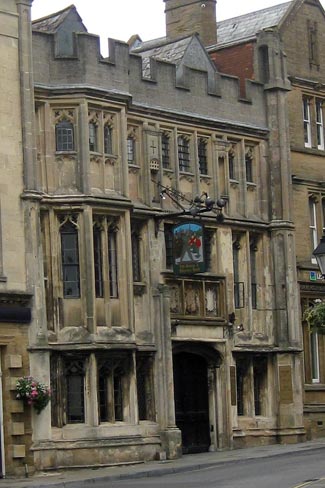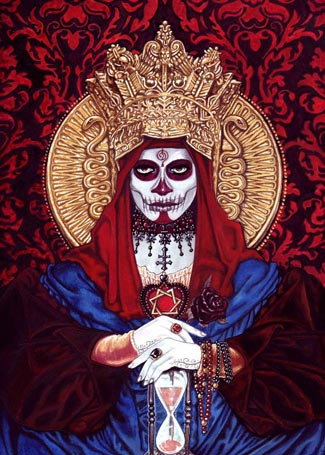The Speakeasy at the Occult Conference in Glastonbury
WordPress database error: [Incorrect DATE value: '']
SELECT * FROM wp_gigpress_artists AS a, wp_gigpress_venues as v, wp_gigpress_shows AS s LEFT JOIN wp_gigpress_tours AS t ON s.show_tour_id = t.tour_id WHERE show_related = 470 AND show_expire != '' AND show_status != 'deleted' AND s.show_artist_id = a.artist_id AND s.show_venue_id = v.venue_id ORDER BY show_date asc,show_expire asc,show_time asc
The 2012 Occult Conference was held on Saturday, 17 March at the George and Pilgrim Hotel and Pub in Glastonbury. The George and Pilgrim, the oldest purpose-built public house in southwest England, was originally constructed in the 1400s to accommodate pilgrims journeying to Glastonbury Abbey. Glastonbury was a magnet for spiritual tourism long before the Abbey was built and it remains so today, as evidenced by the packed attendance at the Speakeasy. Many traveled from far afield to attend.
Five speakers (including me) were scheduled. Talks were held in a private room upstairs. Unlike standard store or theater seating, there were tables, chairs– and wine (not to mention the bar downstairs). The Speakeasy was reminiscent of an occult Golden Globes ceremony, except that we had the sharp and funny Grim Rita serving as compere, rather than Ricky Gervaise. Because of fire regulations, only 60 seats were available for those wishing to partake of the talks. However, there was ample territory for occult shoppers: admission to the vending stalls situated at ground level was free and open to the public. Vendors included the Museum of Witchcraft; publishers Scarlet Imprint and Avalonia, as well as representatives from local stores Covenstead’s Curious Cottage, the Wild Hunt, and Witchcraft Limited. (But that’s just the tip of the iceberg—there were many more vendors.)
Speakers were nicely paced, one after the other, so that participants could attend all talks, if desired. Diverse and interesting topics were covered:
- Julian Vayne discussed Baphomet
- David Rankine talked about grimoires and Books of Secrets
- Josephine McCarthy described Inner Work.
- Jamie Alexzander, organizer of the Speakeasy, explained Hoodoo—the North American folk magic that remains unfamiliar to so many
- I discussed saints, both authorized and unauthorized.
Many find the concept of unauthorized saints to be even more arcane than Hoodoo. (While Hoodoo has historically been exclusively magical, rather than religious, its most recent evolution involves veneration of both official and unofficial saints. You’ll find discussion of Hoodoo in several of my books, including Pure Magic, The Encyclopedia of 5000 Spells, and the new Encyclopedia of Mystics, Saints, and Sages.) It is commonly assumed that all saints are canonized Christian saints, but, in fact, saint veneration predates Christianity and is a phenomenon shared by many spiritual traditions.
Until the concept of “canonization” (“glorification” in the Orthodox Church) arose, all saints were unofficial and unauthorized, if only because no one possessed authority to decide which saints would receive an official stamp of approval—and which would not. With the exception of the saint-venerating branches of Christianity and perhaps Thelema, saints from other spiritual and religious traditions are still recognized the old fashioned way: by popular acclaim. Thus there are no ‘official’ or ‘unofficial’ Buddhist, Jewish, Sufi, or folk saints: their status is determined by devotees alone. However, in regions heavily influenced by Roman Catholicism, particularly Latin America, a potent and historical rivalry exists between devotees of Church-authorized saints and those who lack that stamp of approval. (And if this topic is unfamiliar or confusing, it is explained in greater detail and clarity in the Encyclopedia of Mystics, Saints, and Sages.)
Every day is some saint’s day and as the Speakeasy was held on 17 March, there could be no discussion of saints without mentioning St Patrick. Downstairs, in the pub, there was plenty of wearing of the green to honor Ireland’s most beloved saint. Ironically, there seemed to be little celebration of a saint of tremendous local import, who shares Patrick’s feast day: Joseph of Arimathea. This saint, the other significant Joseph in the life of Jesus, plays a pivotal part in the history of Glastonbury.
The Gospels recount that it was Joseph of Arimathea, who received the crucified body of Christ from Pontius Pilate and arranged for burial. Legends suggest that Joseph then traveled to what is now southern France in the company of fellow future saints Mary Magdalene, Martha of Bethany, and les Maries de la Mer (the Marys of the Sea). While some of these saints may have settled in France, still their presence looms large in Glastonbury:
- The Covenstead, the witchcraft-themed bed & breakfast where I stayed, is situated on Magdalene Street. http://covenstead.co.uk/
- The Occult Consultancy, sponsor of the Speakeasy, is housed nearby in the Saint Martha Botanica. http://theoccultconsultancy.com/
Legend suggests that Joseph of Arimathea did not stay in France, but traveled onwards to Glastonbury, bearing something very secret and very sacred. Many believe he smuggled the Grail out of Judea—although there is little agreement regarding the identity of the Grail. Local Glastonbury lore suggests that Joseph was the uncle of Jesus, a relative on his mother’s side. According to this legend, teenage Jesus traveled with his merchant uncle, possibly even visiting Glastonbury. (More about Joseph of Arimathea’s travels and sojourn in England, as well as theories of the Grail, can be found in the Encyclopedia of Mystics, Saints, and Sages.)
Having acknowledged Patrick and Joseph, who, while canonized, possesses some unauthorized aspects of his own, my talk then focused on unauthorized saints. An excellent question from a Conference participant led to discussion of Argentina’s Difunta Correa. Other unauthorized saints discussed include Juan Soldado, Jesus Malverde, Maximon, Judas Iscariot, and the highly controversial Santa Muerte (Saint Death).
Among my prized souvenirs brought home from the Conference is a signed poster of artist Stuart Littlejohn’s Santissima Muerte. And if you haven’t seen Littlejohn’s divine sacred and magical art, well, you should. Here’s a link to the website he shares with Josephine McCarthy: http://www.theinnerlibrary.org/ His work is available through his website and at the Saint Martha Botanica at 10 Benedict Street, Glastonbury. Santa Muerte’s presence in Glastonbury indicates just how far this much maligned saint has traveled. Twenty years ago she was little known outside Mexico. Today, she is beloved worldwide.
Santa Muerte is somewhat of an anomaly among saints, who are traditionally defined as the souls of those once living, who, although now dead, have not departed the mortal realm, but remain to provide miraculous assistance to the living. Santa Muerte, however, is the embodiment of Death. Some consider her a modern incarnation of the Aztec Lady of Death, Mictlancihuatl, while others perceive her as an angel of death, something akin to the archangel saints, Raphael, Gabriel, and Michael. (Michael’s presence is also exceedingly potent in Glastonbury—his tower atop the Tor dominates the landscape– but that’s the subject of another blog post.) Some would classify her as a goddess, like Kali or Baba Yaga.
The title Santa, however, clearly identifies Santa Muerte as a saint. Within the context of a Catholicized culture, an unauthorized saint is still more generally acceptable than any other kind of spiritual being. Much confusion regarding Santa Muerte exists and she is continually misrepresented in popular and conventional media. No, she does not require blood sacrifices and no, she will not kill one of your loved ones as payment for favors granted.
Detailed, lucid information regarding Santa Muerte, as well as magic spells associated with her, may be found in the Encyclopedia of Mystics, Saints, and Sages. Also found in that book are other skeleton saints, such as Argentina’s San La Muerte and the Mayan Pascualito and El Rey Pascual, as well as all saints discussed in this blog post, both authorized and unauthorized.


